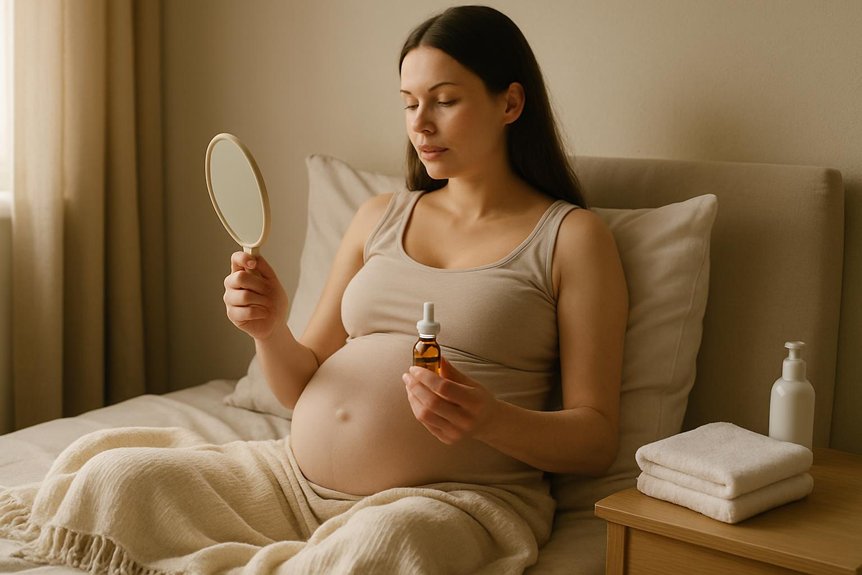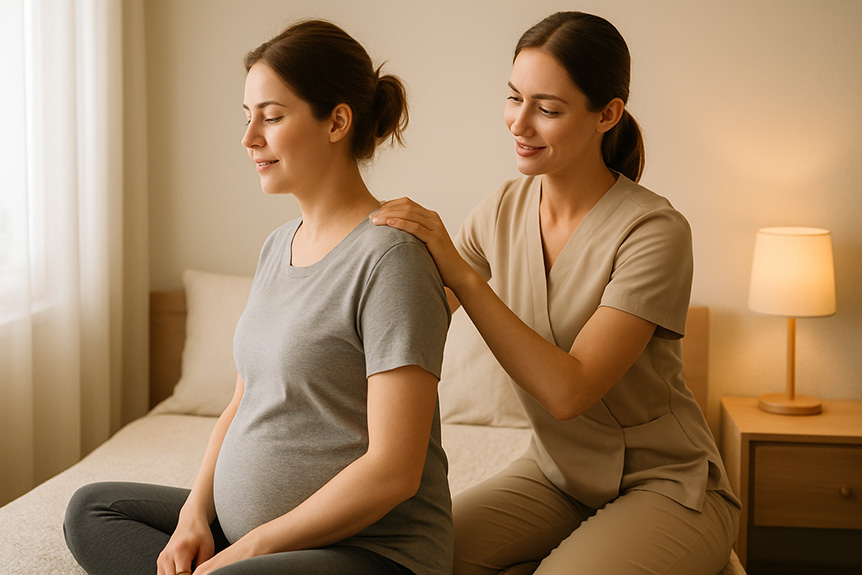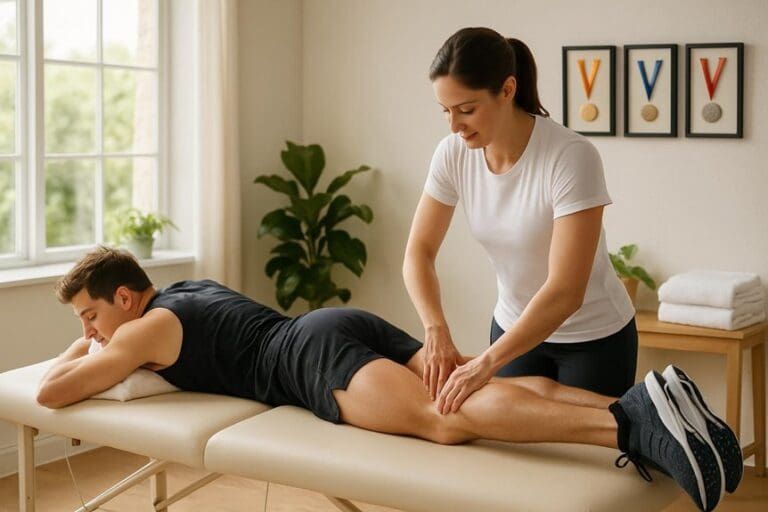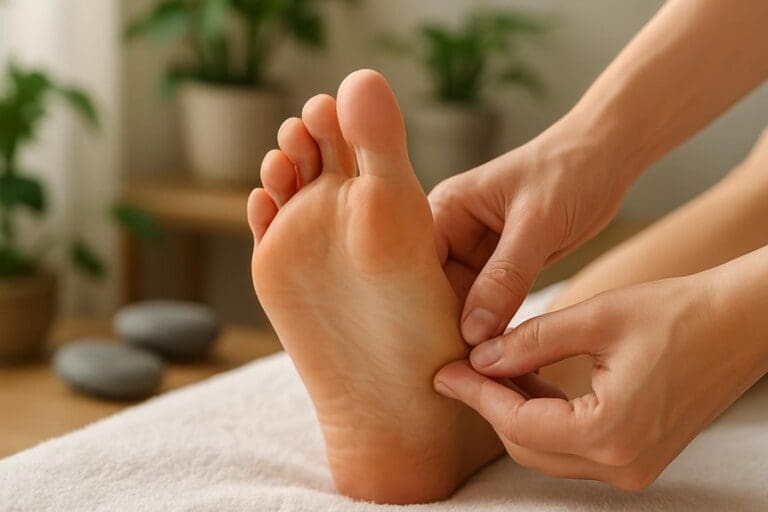Perineal massage is most effective when begun between 34 and 36 weeks of pregnancy. Clinical studies show this timing helps reduce the risk of perineal trauma during childbirth. Before starting, it is essential to consult a healthcare provider to confirm safety, especially if there are any complications, pain, or infections. Consistent practice, about two to three times per week, maximizes benefits. Further details about preparation, technique, and personalized guidance are explored in the following sections.
Understanding Perineal Massage and Its Benefits
Although often overlooked, perineal massage is a specialised technique designed to gently stretch and increase the flexibility of the perineal tissues in preparation for childbirth. This practice involves the careful, methodical application of pressure and massage to the area between the vaginal opening and the anus.
The aim of perineal massage is to reduce the risk of perineal tearing and the need for episiotomy during delivery. Clinical studies indicate that regular perineal massage can enhance tissue elasticity, promote blood flow, and support a more positive birthing experience. Just as deep tissue massage techniques are used to target deeper layers of muscle and connective tissue for lasting physical benefits, perineal massage relies on methodical, evidence-based approaches to help prepare the body for the demands of childbirth.
At Spa & Massage, therapists educate clients about safe, evidence-based techniques, highlighting the importance of comfort and relaxation. By fostering a sense of connection and body awareness, perineal massage can empower individuals to approach childbirth with greater confidence and intimacy.
Recommended Timing for Beginning Perineal Massage
Current evidence suggests that perineal massage is most beneficial when initiated between 34 and 36 weeks of pregnancy. The ideal start time may vary depending on individual factors such as medical history, comfort, and pregnancy progression.
Spa & Massage recommends that clients consult their midwife or healthcare provider before beginning perineal massage to guarantee safety and suitability.
Optimal Weeks to Begin
Based on current clinical guidelines and extensive practitioner experience at Spa & Massage, the ideal time to initiate perineal massage during pregnancy is typically from 34 weeks gestation onward.
This window allows sufficient time for gradual tissue adaptation, optimizing the flexibility and resilience of the perineal area in anticipation of childbirth.
Research suggests that commencing perineal massage in the final six weeks of pregnancy may reduce the likelihood of perineal trauma and the need for episiotomy during vaginal delivery.
Spa & Massage therapists emphasize consistency, recommending massage two to three times per week, ensuring the tissues have regular, gentle stimulation.
This timing supports both physical and emotional preparation, encouraging a deeper connection with one’s body as the birth experience approaches, and fostering confidence in the process.
Factors Influencing Start Time
Several key factors determine the ideal timing for beginning perineal massage during pregnancy. Maternal age, tissue elasticity, previous birth experiences, and the presence of any pregnancy complications each play a pivotal role.
For example, individuals with a history of perineal trauma or surgical births may benefit from a personalised approach to timing, as recommended by experienced therapists at Spa & Massage.
The comfort level and readiness of the individual are also essential, as relaxation and trust support more effective massage outcomes.
Additionally, consideration of any specific medical conditions or sensitivities should guide the decision.
At Spa & Massage, therapists emphasise gentle, tailored techniques and the use of nourishing, hypoallergenic oils to optimise both comfort and safety when introducing perineal massage at the recommended stage.
Consulting Your Midwife
Although perineal massage can offer significant benefits in preparation for childbirth, it is essential to consult a midwife before beginning this practice. A midwife can provide tailored guidance based on an individual’s pregnancy, medical history, and any specific concerns.
Evidence supports beginning perineal massage around 34 to 36 weeks of gestation, but the ideal timing may vary depending on each pregnancy. Midwives can advise on the correct technique, frequency, and choice of oils, ensuring both safety and comfort.
At Spa & Massage, therapists emphasise the importance of this professional consultation, integrating their recommendations into personalised wellness plans. This collaborative approach helps foster intimacy, confidence, and trust, offering reassurance as expectant mothers prepare for one of life’s most intimate milestones.
How to Prepare for Perineal Massage

Proper preparation for perineal massage includes gathering essential supplies such as a gentle, hypoallergenic oil—similar to those recommended by therapists at Spa & Massage—and ensuring clean hands and trimmed fingernails.
Creating a calm, private environment can help reduce tension and support relaxation during the massage.
These steps promote safety, comfort, and effectiveness for expectant mothers beginning perineal massage.
Gathering Essential Supplies
Preparation for perineal massage requires assembling specific supplies to guarantee both safety and effectiveness.
Clinically, a natural, unscented lubricant such as almond oil, vitamin E oil, or a specialist pregnancy massage oil is recommended to minimise friction and irritation.
At Spa & Massage, therapists favour oils that are gentle, hypoallergenic, and free from synthetic additives, supporting the delicate nature of perineal tissue.
Clean hands and trimmed fingernails are essential to prevent accidental trauma or infection.
A mirror may assist in visualising the area, enhancing accuracy and confidence.
Soft, absorbent towels provide comfort and help maintain hygiene.
These supplies not only promote smooth technique but also encourage a sense of intimacy and care, aligning with the nurturing approach valued in Spa & Massage clinics.
Creating a Relaxing Environment
Why is environment so essential to the effectiveness of perineal massage? A calm, private setting reduces distractions and promotes physical and emotional relaxation, which is vital for effective perineal massage during pregnancy.
Research indicates that the body’s response to massage is significantly enhanced in tranquil conditions, as muscles are more receptive and tension is minimized. At Spa & Massage, therapists recommend soft lighting, soothing music, and comfortable positioning, such as reclining with supportive cushions.
Warmth is also crucial, as it helps relax the pelvic area and encourages a sense of safety and intimacy. Using high-quality, hypoallergenic oils—like those preferred in our clinics—further supports gentle, mindful touch.
Creating this environment fosters trust and connection, allowing massage to be both effective and nurturing.
Step-by-Step Guide to Performing Perineal Massage
How can expectant mothers safely perform perineal massage at home? The process begins with clean hands and short, trimmed nails. A comfortable, private space is essential. Using a mirror aids visibility.
In Spa & Massage clinics, therapists recommend a natural, unscented oil—such as sweet almond or vitamin E—for lubrication. The mother inserts one or two lubricated thumbs about 3–4 cm into the vagina, applying gentle, downward and outward pressure toward the anus until a mild stretching sensation is felt. Maintaining this pressure for one to two minutes helps tissues relax.
Next, the thumbs slowly sweep in a U-shaped motion, massaging the lower vaginal wall for five minutes. This technique encourages flexibility, supporting the body’s natural readiness.
Consistency—two to three times weekly—is advised for favorable benefit.
Safety Tips and Precautions for Expectant Mothers
Although perineal massage can offer benefits in preparing the body for childbirth, it is essential to observe key safety measures throughout the process. Expectant mothers should only begin perineal massage after receiving approval from their healthcare provider, particularly if they have a history of vaginal infections or pregnancy complications.
Hands must be thoroughly washed before and after the procedure, and only clean, hypoallergenic oils—such as those recommended by Spa & Massage therapists—should be used to minimise irritation. Gentle, slow movements are important to avoid discomfort or injury.
Any pain, bleeding, or unusual symptoms should prompt immediate cessation and medical consultation. At Spa & Massage, therapists advise maintaining open communication with healthcare professionals to ensure the massage complements overall pregnancy wellness and safety.
How Our Therapists at Spa & Massage Support Pregnancy Wellness

Following appropriate safety precautions lays the foundation for effective pregnancy wellness practices. At Spa & Massage, therapists are extensively trained in pregnancy-specific techniques, ensuring every session is tailored to the unique physiological changes experienced during this period.
Each treatment begins with a thorough consultation, allowing therapists to design a care plan that reflects the client’s trimester, health history, and personal comfort.
Therapists employ gentle, evidence-based methods, prioritising relaxation, improved circulation, and relief from common pregnancy discomforts.
In accordance with best-practice guidelines, only safe, hypoallergenic oils are used.
Clients are supported with positioning aids to maintain ideal safety and intimacy throughout their visit.
Conclusion
Perineal massage, when started from around 34 weeks of pregnancy, can dramatically benefit expectant mothers by reducing the risk of perineal trauma. In fact, studies show that regular perineal massage can lower the likelihood of needing an episiotomy by up to 16%. With proper technique and timing, mothers can approach childbirth with increased confidence and comfort. Spa & Massage’s evidence-based guidance empowers women to incorporate this effective practice into their holistic prenatal care routines.



